
Transfer is important in all learning, but it is especially important in language-learning contexts. The purpose of this paper is to present practical, research-based strategies that address universal literacy skills common to both the English and Spanish languages as well as language-specific skills unique to each language. Contrastive analysis of skills will also be addressed, as will caveats regarding less effective practices.
Background
The National Reading Panel report (2000) provided literacy educators and researchers with a synthesis of research studies to guide educational practice and inform educational policy. The panel identified five research-based elements necessary for providing successful literacy instruction: phonics, phonemic awareness, reading fluency, vocabulary, and reading comprehension. Then, the National Literacy Panel on Language-Minority Children and Youth report (August and Shanahan, 2006) compiled the research on the differences and similarities between language-minority and native speakers in the development of various literacy skills in societal languages in addition to English.
A major conclusion of the panel’s meta-analysis of a database of 293 studies revealed that while the process of learning to read and write is essentially the same across alphabetic languages such as English and Spanish, effective instruction for multilingual learners must address the specific linguistic characteristics of the languages. This research points to the cross-linguistic pathways for developing biliteracy in English and Spanish. When learning a new language, cross-linguistic transfer is most evident and critical, as those seeking to learn a new language apply what they already know in their first language to support their pursuit of high levels of language and literacy in the new language.
Reading Comprehension
Providing a solid foundation for literacy is critical for students who are already bilingual or are learning a second language. Strong oral language skills support early literacy development in both a child’s native language and a new language (Fillmore, 2002). Learning to read and write in a language that is not fully understood represents a double challenge for multilingual learners. Research speaks directly to the need for a better understanding of the skills that influence second-language reading comprehension in Spanish/English bilinguals. However, there is a unique contribution to reading comprehension from metacognitive skills such as making inferences and comprehension monitoring. Comprehension monitoring is the reader’s mental act of knowing when they are or are not comprehending the meaning of a text (Moats, 2001).
The ability to engage in comprehension monitoring does not differ by language, but it depends on language competence. Metacognitive skill, or “thinking about thinking,” is transferable because multilingual learners avail themselves of thinking skills and processes that they acquire in their first language and apply them to reading comprehension in their new language. Therefore, biliteracy instruction builds on concepts learned across languages and promotes metalinguistic awareness and metacognitive skills.
Foundational literacy is part of language development for multilingual students, particularly in the early grades, and cannot be taught in isolation; meaning making must be an integral element of literacy instruction (Language and Reading Research Consortium et al., 2021).
Word Recognition:
Phonological and Phonemic Awareness
In both the English and the Spanish language, phonemic awareness is taught directly, explicitly, systematically, and prior to sound–spelling correlations. Instruction includes larger units of phonological awareness at word, syllable, and phoneme levels. Phonological awareness tasks include isolation, segmentation, blending, deletion, substitution, and reversal.
Research has demonstrated that the ability to blend and segment individual phonemes is a strong predictor of overall reading achievement in English, in Spanish, and for Spanish/English bilingual children. Pollard-Durodola and Simmons (2009) state, “If phoneme blending and segmentation have been taught and mastered in Spanish, then it is conceivable that the linguistic readiness primed by instruction and practice in Spanish will facilitate transfer to English, therefore allowing English phonemic awareness instruction on high-priority skills to be abbreviated” (p. 147).
The use of Elkonin Boxes is a fun and engaging way to build phonological awareness in English and Spanish. Teachers pronounce a word slowly, stretching it out by sounds. Students repeat and pronounce the word while moving a token into a box to represent the sound. This encourages students to listen for each individual sound in a word.
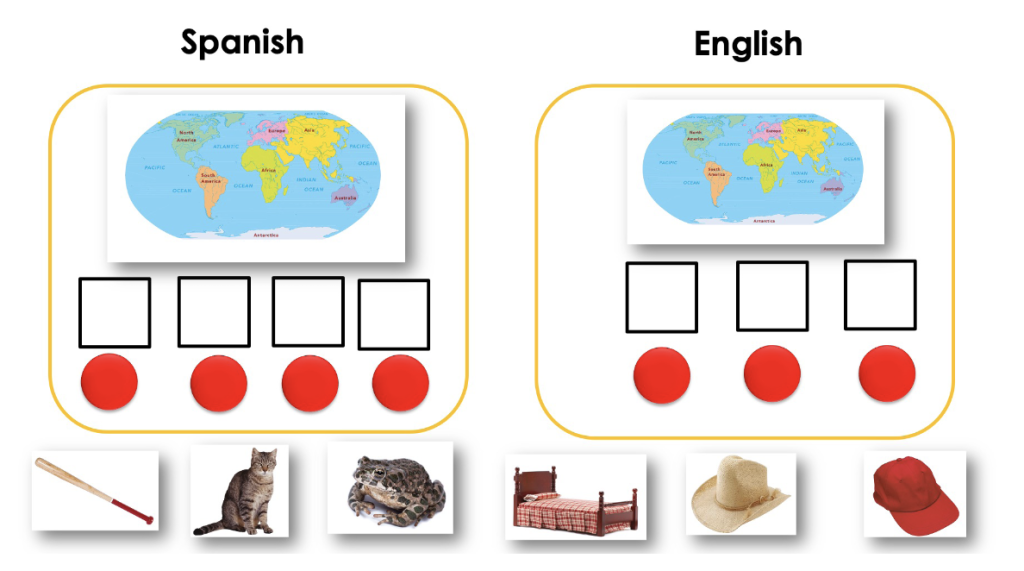
Spanish-Specific Instruction
In Spanish, phonological awareness extends to accentuation, where it includes awareness of the stressed syllable in a word. Instruction related to accentuation is presented beginning with syllabication and the identification of syllabic stress in kindergarten. Concepts continue building systematically and sequentially as the language conventions that govern accentuation in Spanish are taught at each subsequent grade level.
The written Spanish accent mark (tilde) indicates the pronunciation of words in decoding and frequently distinguishes the meaning of the word.
Caveat
A key contrast between Spanish and English literacy instruction is the use of onset–rime structures. Identifying onset and rime is a way to segment words. Onset is defined as the initial part of the word that precedes the vowel. Rime is the vowel and consonants that follow in the word. In English, rimes are an effective tool because they form the basis for recognizing sound chunks and patterns, primarily in single-syllable words, facilitating recognition of words and of patterns in word families. On the other hand, in Spanish, it is the phonological awareness of the syllable and syllabic structure that facilitates orthographic patterns and word recognition. Spanish is a syllabic language with a regular and well-defined syllabic structure, which is the most important unit of phonological awareness in the language (Araya Ramírez, 2019).
Phonics Instruction
In both English and Spanish, letter–sound correspondences are taught in an explicit, systematic instructional sequence using manipulatives and high levels of student engagement and interaction. Segmenting and blending are explicitly studied each day with meaningful practice and spiral review. Phonic skills taught are applied in matched decodable text, securing and affirming students’ decoding skills.
While understanding the close relationship between phonological awareness, phonics, and word recognition, instruction for biliteracy considers the transferability of sound–spelling relations across languages.
Sound–spelling relationships in English and Spanish can be fully transferable, partially transferable, or nontransferable (Language and Reading Research Consortium et al., 2021). Fully transferable sound–spellings are equivalent in Spanish and English, such as the /m/ spelled m. Partially transferable sound–spellings may represent the same sound in English and Spanish; however, the spelling may differ, for example /k/ spelled que and qui in Spanish. Nontransferable sound–spellings have the same spelling but not the same sound, for example, the letter h is silent in Spanish, but in English the letter h is pronounced /h/.
There are many sound–spelling correspondences in Spanish that are directly transferable to English. This means that students who can recognize these sound–spellings in Spanish have a strong foundation for learning English phonics. As teachers introduce Spanish readers to English phonics, they can draw on a large number of phonics elements that are common to both languages.
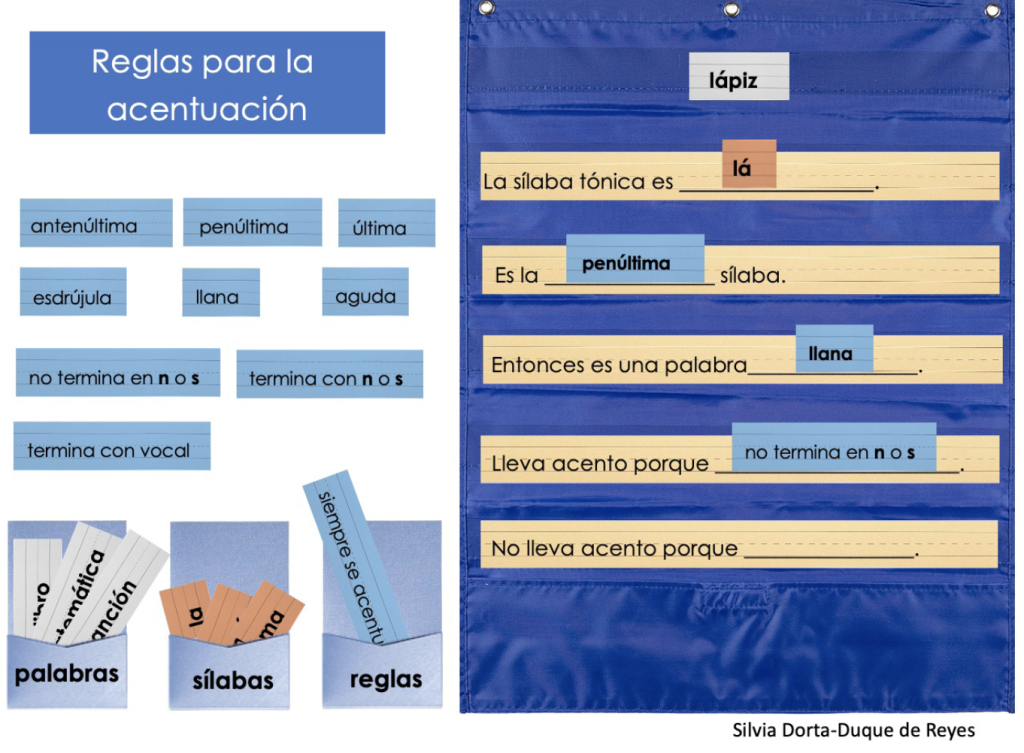
Caveat
When teachers understand the similarities and differences between the two languages, they are able to plan and deliver instruction that facilitates and supports cross-linguistic transfer.
Some students may recognize similarities and differences between languages on their own, making an intuitive leap in applying what they know about their known language to the new language. However, rather than being up to chance, this cross-linguistic transfer must be intentionally and strategically taught. Explicit teaching for linguistic transfer builds a deeper knowledge about the shared elements and the unique features of each language and how each language works.
By intentionally providing a comprehensible connection between languages, teachers guide students to become more strategic thinkers. As students think about the languages they are using and learning, they develop the metacognitive skills and metalinguistic knowledge needed for proficient biliteracy.
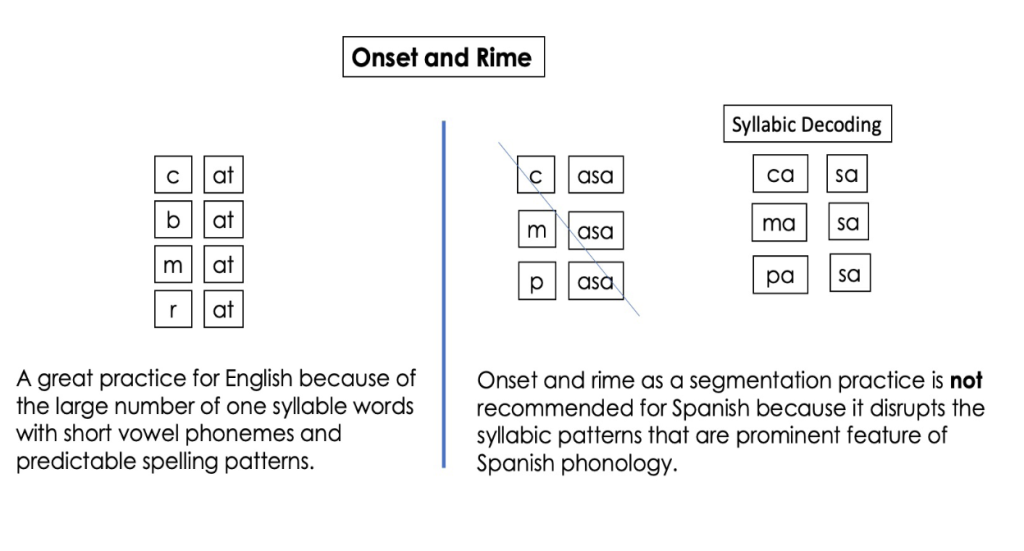
High-Frequency Words
Learning high-frequency words enables children to devote their energy to decoding words that are unfamiliar. In Spanish, all high-frequency words are decodable; therefore, a more functional and grammatical instructional approach is recommended. High-frequency word analysis from a syntactical perspective considers the function and use of words for oral and written production, not just for reading (Real Academia Española, 2010).
Students will be able to recognize these words when reading but also to use them when speaking and writing simple sentences. Articles such as un, una, el, la, and their corresponding plurals are presented as they appear in context. Forms of the verbs ser and estar are also considered high-frequency words (soy, eres, es, somos, estoy, estas, estamos). Pronouns (yo, tú, el, ella, nosotros, ustedes, ellos) are all high-frequency words taught for automaticity. High-frequency words are always taught in context and practiced for fluency and in writing through dictados (the traditional Spanish approach to spelling).
Dictado
Dictado is an integrated approach to spelling (spelling, punctuation, syntax, grammar) used predominantly in Spanish literacy instruction (Escamilla et al., 2013).
Instead of a one-word-at-a-time spelling assessment, in kindergarten and first grade, the dictado comprises the dictation of a whole sentence. In the upper primary grades, dictado is connected text. The dictado sentence includes high-frequency words and words containing the specific phonetical element that is explicitly studied. All words come from the texts studied during the week. Teachers may choose from both options: the dictado or the single-word spelling approach associated with English spelling.
Mora (2016) examined cross-linguistic spelling approximations and identified categories that are very useful in evaluating students’ generalizations across languages as they apply their emerging knowledge of sound–spelling relationships in each language. The miscues or approximations represent students’ efforts as they draw upon what they know to transcribe phonemes to the target language.
Caveat
When teachers understand the similarities and differences between the two languages, they are able to plan and deliver instruction that facilitates and supports cross-linguistic transfer.
Some students may recognize similarities and differences between languages on their own, making an intuitive leap in applying what they know about their known language to the new language. However, rather than being up to chance, this cross-linguistic transfer must be intentionally and strategically taught. Explicit teaching for linguistic transfer builds a deeper knowledge about the shared elements and the unique features of each language and how each language works.
By intentionally providing a comprehensible connection between languages, teachers guide students to become more strategic thinkers. As students think about the languages they are using and learning, they develop the metacognitive skills and metalinguistic knowledge needed for proficient biliteracy.
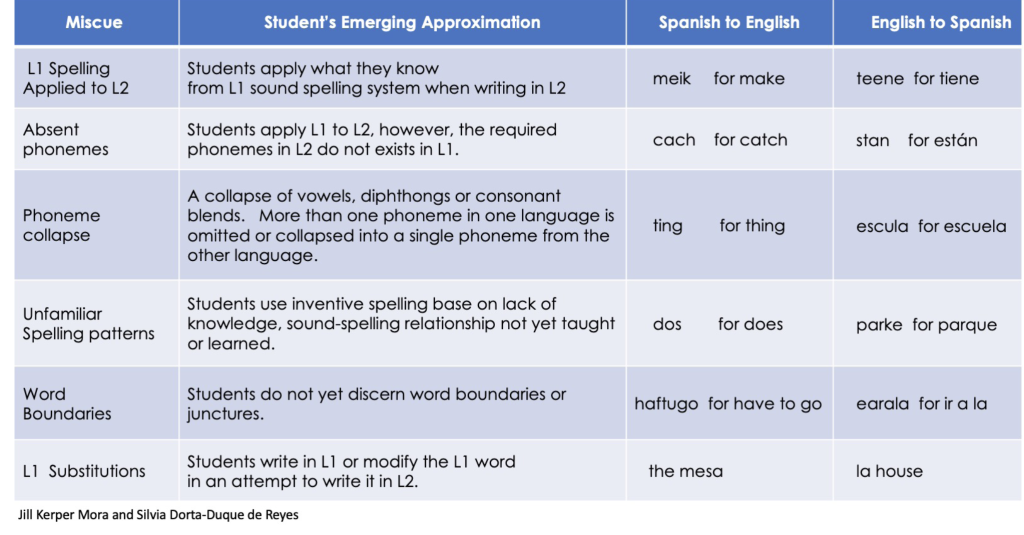
High-Frequency Words
Learning high-frequency words enables children to devote their energy to decoding words that are unfamiliar. In Spanish, all high-frequency words are decodable; therefore, a more functional and grammatical instructional approach is recommended. High-frequency word analysis from a syntactical perspective considers the function and use of words for oral and written production, not just for reading (Real Academia Española, 2010).
Students will be able to recognize these words when reading but also to use them when speaking and writing simple sentences. Articles such as un, una, el, la, and their corresponding plurals are presented as they appear in context. Forms of the verbs ser and estar are also considered high-frequency words (soy, eres, es, somos, estoy, estas, estamos). Pronouns (yo, tú, el, ella, nosotros, ustedes, ellos) are all high-frequency words taught for automaticity. High-frequency words are always taught in context and practiced for fluency and in writing through dictados (the traditional Spanish approach to spelling).
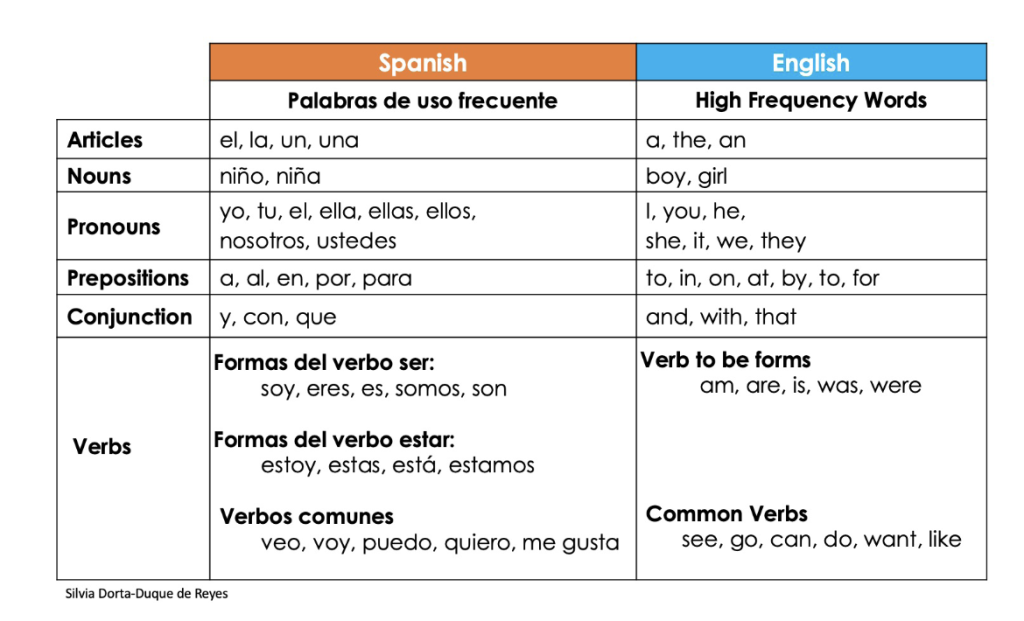
Dictado
Dictado is an integrated approach to spelling (spelling, punctuation, syntax, grammar) used predominantly in Spanish literacy instruction (Escamilla et al., 2013).
Instead of a one-word-at-a-time spelling assessment, in kindergarten and first grade, the dictado comprises the dictation of a whole sentence. In the upper primary grades, dictado is connected text. The dictado sentence includes high-frequency words and words containing the specific phonetical element that is explicitly studied. All words come from the texts studied during the week. Teachers may choose from both options: the dictado or the single-word spelling approach associated with English spelling.
Mora (2016) examined cross-linguistic spelling approximations and identified categories that are very useful in evaluating students’ generalizations across languages as they apply their emerging knowledge of sound–spelling relationships in each language. The miscues or approximations represent students’ efforts as they draw upon what they know to transcribe phonemes to the target language.
Fluency and Comprehension
Oral language development is an essential component of foundational skills instruction for multilingual learners. Both decoding and meaning making are fundamental to oral and reading comprehension. Fluency is an indicator of comprehension because the readers’ ability to decode with automaticity and prosody depends on their ability to make the written language sound like internalized oral language (Calet et al., 2015).
English-proficient students acquire oral language skills that are foundational to learning how the sounds of English are mapped onto print to develop literacy in English (Moats, 2001). Likewise, multilingual learners also need to develop and internalize English oral language skills for meaning making and reading comprehension.
In both English and Spanish there are similar methodologies and learning tasks associated with fluency: reading aloud, demonstrating prosody, incorporating repeated readings, echo reading, chiming, and paired reading. Teachers explain to students that reading fluency means reading with purpose at the right pace. The use of voice to express meaning is emphasized, while careful attention is paid to pausing and phrasing punctuation.
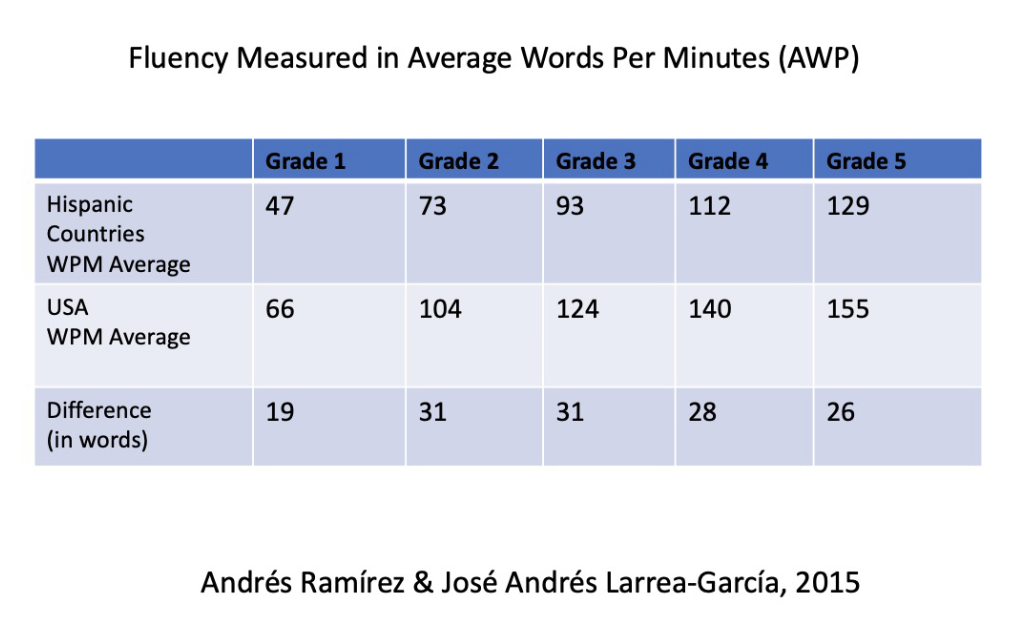
Caveat
In Spanish, fluency is practiced by reading words, phrases, and sentences. Because Spanish has such a transparent orthography, oftentimes children can decode far beyond the level at which they comprehend. This approach not only helps develop automaticity with multisyllabic words but promotes comprehension while reading (López-Escribano et al., 2013). Fluency rates for English are not applicable to Spanish oral reading. English fluency rates average 27 words more per minute than Spanish rates. A “total words per minute” scoring guide normed with English readers reading English passages is not a valid measure for Spanish reading fluency (Ramírez and Larrea-García, 2015).
Conclusion
Building metacognitive and metalinguistic knowledge informed by contrastive linguistics is essential for literacy and biliteracy. Instruction is enhanced when teachers understand and articulate how languages work.
Teachers can explicitly teach students to develop and apply cross-linguistic understandings with increasing skill and
complexity.
Foundational skills development should explicitly call attention to the similarities and differences between specific features of English and students’ home languages to advance the transfer of metacognition and metalinguistic knowledge, resulting in biliteracy.
References
Araya Ramírez, J. (2019). “Los principios de la conciencia fonológica en el desarrollo de la lectoescritura inicial [The Principles of Phonological Awareness in the Development of Initial Reading and Writing].” Revista de Lenguas Modernas, 30, 163–181.
August, D., and Shanahan, T. (Eds.). (2006). Developing Literacy in Second-Language Learners: Report of the National Literacy Panel on Language-Minority Children and Youth. Lawrence Erlbaum Associates.
Calet, N., Defior, S., and Gutiérrez-Palma, N. (2015). “A Cross-Sectional Study of Fluency and Reading Comprehension in Spanish Primary School Children.” Journal of Research in Reading, 38(3), 272–285.
Escamilla, K., Hopewell, S., Butvilofsky, S., Sparrow, W., Soltero-González, L., Ruiz-Figueroa, O., and Escamilla, M. (2013). Biliteracy from the Start: Literacy Squared in Action. Caslon Publishing.
Fillmore, L. W., and Snow, C. E. (2002). What Teachers Need to Know about Language. McHenry, IL: Delta Systems.
Jiménez, J. E., and Ortiz, M. R. (2000). “Metalinguistic Awareness and Reading Acquisition in the Spanish Language.” Spanish Journal of Psychology, 3(001), 37–46.
Language and Reading Research Consortium, Mesa, C., and Yeomans-Maldonado, G. (2021). “English and Spanish Predictors of Grade 3 Reading Comprehension in Bilingual Children.” Journal of Speech, Language, and Hearing Research, 64(3), 889–908.
López-Escribano, C., Melosúa de Juan, M. R., Gómez-Veiga, I., and García-Madruga, J. A. (2013). “A Predictive Study of Reading Comprehension in Third-Grade Spanish Students. Psicothema, 25(2), 199–205.
National Reading Panel (2000). Teaching Children to Read: An Evidence-Based Assessment of the Scientific Research Literature on Reading and Its Implications for Reading Instruction. US Government Printing Office.
Moats, L. C. (2001). Speech to Print: Language Essentials for Teachers. Paul H. Brookes.
Mora, J. K. (2016). Spanish Language Pedagogy for Biliteracy Programs. Montezuma Publishing.
Pollard-Durodola, S. D., and Simmons, D. C. (2009). “The Role of Explicit Instruction and Instructional Design in Promoting Phonemic Awareness Development and Transfer from Spanish to English.” Reading and Writing Quarterly, 25, 139–161.
Ramírez, A., and Larrea-García, J. A. (2015). “A Descriptive Framework for Integrating Fluency, Comprehension, and Cognate Awareness for Emergent to Advanced Bilinguals.” La Cosecha: 20th Annual Dual Language Conference. Albuquerque, NM. November 4–7.
Real Academia Española (2010). Ortografía de la lengua española: El sistema ortográfico del español. Asociación de Academias de la Lengua Española.
Silvia Dorta-Duque de Reyes coordinated the Spanish translation and linguistic augmentation of the Common Core State Standards for language arts and mathematics. She is well known for her contributions in the areas of curriculum design, English language arts, English language development, Spanish language arts, and explicit cross-linguistic instruction. She is a national biliteracy consultant and author at Benchmark Education.







